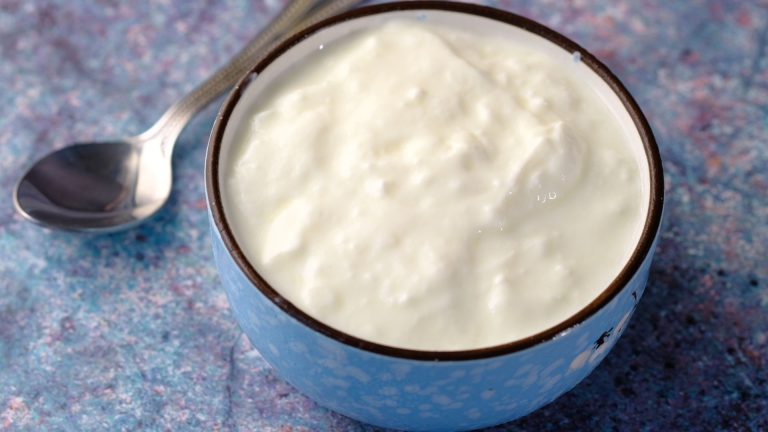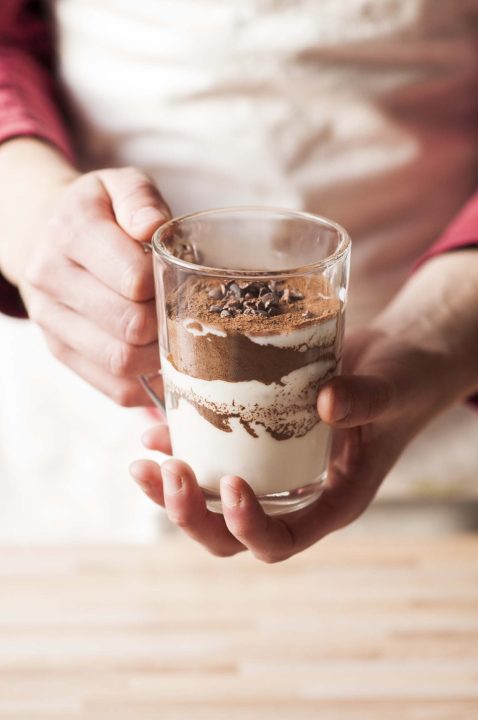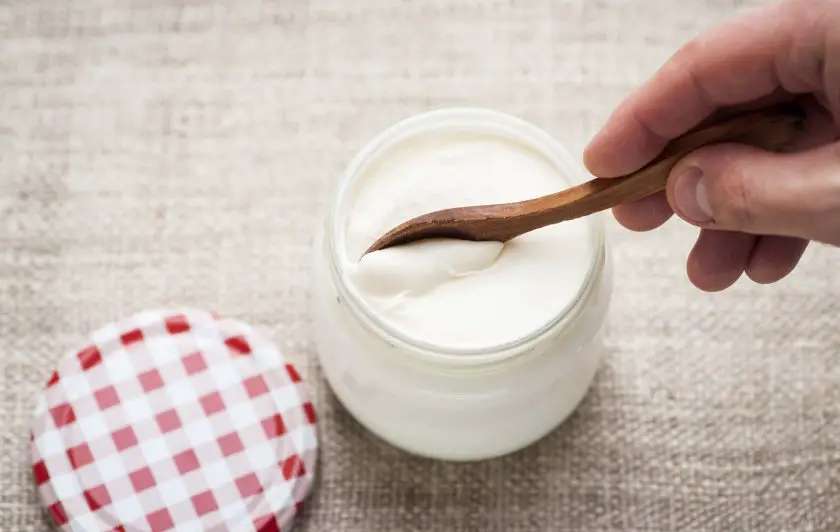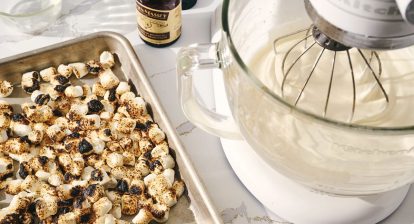I like the basics. Or rather, I like to go back to basics. It's like coming home, very sensible. For me, one of the most inspiring 'back to basics' rituals is making basic, simple and nutritious foods like sourdough bread and other fermented foods – especially vegetables and yogurt. I have made homemade yogurt many times and I can't believe how excited, happy, proud of myself and inspired I am every time I make it.

Table of Contents

- 3 liters of fresh raw cow's milk
- 300 g of yogurt
- Pour the milk into the saucepan and heat to 40°C/104°F. Stir occasionally to heat evenly. You can heat your milk up to 90°C, however, in this way the milk will be pasteurized and some beneficial bacteria and nutritional components will not be there for you in their full extent.
- When hot, pour in your extra yogurt and mix well. By doing this you will introduce bacteria that feed on lactose (a sugar naturally present in milk) into the milk. The product of bacterial digestion is called lactic acid, which has a beneficial effect on our intestines. The process where sugars are converted into lactic acid is called lactic acid fermentation. If you have any probiotics in capsules (dietary supplements, you can also add these, it will enrich the taste of yogurt and the bacterial diversity of lactic acid (Lactobacillus bulgaricus, lactobacillus acidophilus,…).
- Pour the heated milk with bacteria into the jars of your choice. I like to use glass jars which I wash well before use.
- Cover the jars with lids and place in a warm place for 7-8 hours (temperature between 38-41°C/100-105°F), either oven, dehydrator or warming room. I use a dehydrator which I set at 40°C for 8 hours. At that time the lactic acid bacteria will multiply. Bacteria that thrive in warm environments are called thermophiles.
- Once done, transfer the jars to the refrigerator and let them cool. In the refrigerator, the fermentation process continues. This time, the psychrotrophic bacteria that thrive in the cold environment do their job. Yogurt curdles and also takes on its distinctive sour flavor. Enjoy!
- Preparation time: 8 hours
- Category: side dish
- Kitchen: European, Asian, Middle Eastern
The benefits of making yogurt at home
The thing I absolutely love about making homemade food is being able to choose the ingredients. With homemade yogurt, I always go for local milk from grass-fed, pasture-raised cows (these cows usually get more sun than I do…). This way I support local agriculture and get the best quality as well.
Second, but not least, is how cheap it is to make homemade yogurt. I get 1 liter of plain yogurt for only 1 euro – is that good or what?
Homemade yogurt recipe
yields: 3.3 liters of homemade yogurt
Ingredients for homemade yogurt
- 3 liters of fresh, raw cow's milk
- 300g yogurt starter (yogurt from the batch or previous store bought yogurt with live cultures (I like to buy my yogurt at the farmer's market where I get one that has been heated to no more than 60°C/140°F))
Instructions on how to make yogurt at home
- Pour the milk into the saucepan and heat to 40°C/104°F. Stir occasionally to heat evenly. You can heat your milk up to 90°C, but this way the milk will be pasteurized and have some beneficial bacteria and the nutrients will not be there for you in their full measure.
- When hot, pour in your extra yogurt and mix well. By doing this you will introduce bacteria that feed on lactose (a sugar naturally present in milk) into the milk. The product of bacterial digestion is called lactic acid, which has a beneficial effect on our intestines. The process where sugars are converted into lactic acid is called lactic acid fermentation.
- Do you have any probiotics in capsules (dietary supplements, you can also add these, it will enrich the taste of yogurt and the bacterial diversity of lactic acid (Lactobacillus bulgaricus, lactobacillus acidophilus, etc.).
- Place the warmed milk with bacteria in the jars of your choice. I like to use glass jars which I wash well before use.
- Cover the jars with lids and place in a warm place for 7-8 hours (temperature between 38-41°C/100-105°F), either oven, dehydrator or warming room. I use a dehydrator which I set at 40°C for 8 hours. At that time the lactic acid bacteria will multiply. Bacteria that thrive in warm environments are called thermophiles.
- Once done, transfer the jars to the refrigerator and let them cool. In the refrigerator, the fermentation process continues. This time, psychotropic bacteria that thrive in a cold environment do their job. Yogurt curdles and also takes on its distinctive sour flavor. Enjoy!
counsel: Yogurt gets better in the refrigerator day after day, but remember to use it within 14 days.
To make homemade yogurt easy, I made a short video (delicious good yogurt instructions are included!).
The varieties of yogurt recipes are countless. My two absolute favorites are rye bread yogurt on my gluten days and generous yogurt on my gluten free days. In our kitchen, the best recipes come from leftover ingredients. And that's how generous yogurt was born. A little cocoa powder and desiccated coconut and your healthy snack is ready in a minute.

Bounty Yogurt Recipe
Ingredients for Bounty Yogurt
yields: 1 portion
- 1 cup homemade yogurt
- 2 teaspoons of raw cocoa powder
- 4-10 tablespoons desiccated coconut (the more the better :))
- 1 syringe liquid vanilla stevia (about 15 drops or sweeten to your taste)
Instructions on how to prepare Bounty Yogurt
- First, pour half of the yogurt into the cup and mix it with stevia.
- Add cocoa powder and 2 tablespoons of coconut.
- Pour over the second half of the yogurt.
- Add cocoa and desiccated coconut again.
Or simply – mix all the ingredients together and sprinkle the porridge with some cocoa.
I like to make the porridge in the evening and then leave it in the fridge overnight. In the morning, it's ready for my breakfast.

Have you ever made yogurt at home? how was it? How do you like to make homemade yogurt? What is your favorite way to eat yogurt?
Tell me about your experience in the comment below.
Some sourdough recipes that will go really well with this:
Asking yogurt frequently asked questions
Is homemade yogurt healthier?
When you make homemade yogurt, you can control the ingredients that go into it, which can make it healthy. Homemade yogurt is generally made from simple, natural ingredients like milk and probiotics. The health benefits will depend on the quality of the milk and the type and amount of probiotics used. It's important to note that not all homemade yogurt is necessarily healthier than store-bought yogurt. Some store-bought yogurts may contain additional nutrients, such as vitamin D. In addition, if the milk used to make yogurt at home is not properly pasteurized or if the yogurt is not stored at the proper temperature, it can pose health risks. your
Is it worth making your own yogurt?
Making your own yogurt can be worth it if you're looking for cost savings, customization, and health benefits, and you're willing to put in the time and effort to get it right.
How to make thicker yogurt?
If you prefer a thicker consistency to your yogurt, there are several techniques you can use to achieve it: use whole milk, add milk powder, strain the yogurt, use a thickener, use a starter culture (like Greek yogurt).
It is important to note that the thickness of the yogurt will depend on several factors, including the temperature and duration of fermentation, the type of milk used, and the amount and type of starter culture used.







